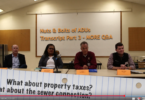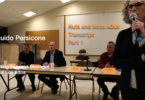County Supervisor Joe Simitian and the public heard over 25 teachers tell their personal stories about struggling to find affordable housing located within a bearable commute to their school. At the March 28, 2018 meeting, Bay Area Forward representatives explained that teachers, even starting teachers, made too much money to qualify for subsidized BMR housing programs. Yet even mid-career teachers didn’t make enough money to afford market-rate rentals or home purchases in this area. “Since 2015, only 1% of housing units in the Bay Area have been built at a price affordable to the ‘missing middle’.” Yes, there is a chronic homeless problem, but we also have an acute shortage of missing middle housing.

Sarah Chaffin and Maya Perkins of Bay Area Forward summarizes the missing middle housing crisis and introduced County Supervisor Joe Simitian.
Some partial solutions were described by Los Altos Mayor Mordo, Joe Simitian and architect Karen Parolek.
City of Los Altos Mayor Mordo explained that the City hopes a new State zoning law will encourage more granny units (“600 to 800 square feet”) to be built. Council is considering imposing an Affordable Housing Impact Fee on all new development – both commercial and residential – within the City in order to build up a fund to subsidize housing. A BMR project on a downtown parking plaza is also being considered.
Santa Clara County Supervisor Joe Simitian explained how a proposed BMR project with 60 to 120 units for teachers located near California Street, Palo Alto, could help lower the monthly rental bill for younger teachers. He is big believer in pushing the responsibility for producing market rate housing back on the largest employers that create the all the new jobs — Stanford, Facebook, Google. He pointed out that Google is finally building some market rate housing in the North Bayshore Plan Area in Mountain View and folding in some “inclusionary” BMR units.
NEXT SECTIONS BELOW:
The American Dream of Home & Yard Ownership is alive
How the Commute is Killing Extra-Curricular activities
Reviving the Creation of Low-rise, Missing Middle Architecture
Teacher Stories – American Dream of Home&Yard ownership
Lalahpolitico: It looks like the elected officials’ current focus on subsidized rental living quarters for our local teachers only meets maybe a quarter of the actual need. Many teachers really want/need to OWN.
About 5 speakers were single, unmarried-childless, wanting affordable rent and apartments closer to their school Some teachers are commuting from Oakland or Gilroy.
About 5 speakers were single moms, sharing a too-small apartment with a growing child. They dream of being able to afford an apartment with an extra bedroom…within a tolerable commute.
About 20 teachers – women and men – spoke about trying to purchase something. A condo with a little yard, maybe a real house, but where? Many of these have a spouse and at least one child.
Some were single and were focused on the benefits of ownership, the ability to accumulate equity over 30 years that could supplement their retirement. “The teacher pension isn’t that good.” [Lalahpolitico: and we know about the CALSTERS pension problems.]
A couple of teachers spoke of losing a house they had rented for over 10 years…when the owner needed to sell.
One teacher said that a small granny unit (600-800) is not enough space for even a family of three – 2 parents and 1 child.
Several teachers mentioned that they had considered trying to use financing from Landed.com to help with a purchase by doubling their downpayment. But all felt the Landed.com shared appreciation 2nd mortgage (SAM) arrangement (25%) would give away too much. [Our post on SAMs here.]

Jeff Baier, LASD Superintendent…the housing need is across the teacher career cycle, not just at the beginning
Dave Campbell, the MVLA high school district CTA President, talked about some teacher survey results (3 year old data)
- 45% rent
- 21% spent over 40% of income on housing
As LASD Superintendent Jeff Baier summed it up, the affordable housing need is across the teacher career cycle, not just at the beginning. At about 5+ years of LASD experience, LASD wants to retain these teachers. But this is when they marry and[/or] want to start raising a family. They may move out of the area; we lose those mid-career, experienced and talented teachers because of the housing crisis.
Teacher Stories – Commutes killing extra-curricular programs
Beth Leach, President of the CTA at LASD Elementary made several observations. She explained that in response to rising rents and the shortage of missing middle housing, many teachers have moved to south San Jose. Teachers who are using route 85 to go home are looking at a 2-hour return home commute. This means it is now too difficult for some teachers to spend time with students in after class clubs or tutoring, as used to be the custom. For teachers who have families and small kids, this is a huge issue. The district has lost a lot of student enrichment due to the missing middle housing crisis.

Because teachers live far from their school, they spend way too much time in their cars commuting up to 2 hours in one direction. Their families suffer. Student after-school activities suffer.
David Campbell, President of the CTA at MVLA High School District: “Recently we are having major hiring problems. We offer a teacher a job, but they turn it down, saying they can’t afford the rent or they can’ afford the drive.” He described the results of a teacher survey taken 3 years ago. He believes the missing middle housing situation has only worsened since then.
- 38% live more than 30 minutes away
- 50% spent a minimum of 10 hours extra outside of workday, M-F
- 20% spend more than 16 hours on extras, M-F and may stay until 6 or 7 pm
- single teachers may be “adjuncts”/student supervisors at extra-curricular sports
As high school teachers marry and have a family, they become less and less able to engage in extra-curricular programs. One teacher who lives in Gilroy carpools with another teacher. They have a 60-minute morning commute and a 90-minute pm commute. This particular teacher used to be a former athletic director but he reduced his load to being a coach, and now he needs to do even less extra-curriculars in order to spend more time with his children.
“Teachers are leaving our district constantly. They can’t afford to live here…The affordability crisis, the missing middle housing crisis is undercutting our ability to create a diverse teacher community. ” – Dave Campbell

David Campbell (MVLA CTA President) on the left cracks a joke. Left to right Beth Leach (LASD CTA President), Steven Levy, ( Director and Economist, Center for Continuing Study of California Economy, Board member of Bay Area Forward), Karen Perlick (CFO of Opticos Design) an architecture firm.
Gallows Humor – Solution for Better Housing!
Simitian asked the group: “What are some solutions you’ve heard of.” [silence]. “Oh, that silence was way too long.” [laughter] MVLA CTA President: “I have heard some teachers say since they do work near Google and Apple perhaps they could MARRY SOMEONE who works there for $$$$$.” [even more laughter]

Where do low-rise duplex, triplex, 8-plex, bungalow courtyard architecture fit into the neighborhood? They can provide a gradient from between 4- 5- story or 8-9- story buildings and the single family homes somewhat further away. Homes and the plexes are often intermixed in older neighborhoods. Perlick wants to revive this suburban pattern.
Reviving Missing Middle Housing Forms
Karen Parolek of Opticos Design gave a short presentation about low-rise duplex, 4-plexs and 8-plexs. She showed where they fit in the gradient from urban high and mid-rise zones… through the missing middle housing forms …to suburban detached single-family homes.
She explained that our historic neighborhoods have plenty of other options besides detached single-family homes. They have low-rise bungalow courts, 8-plexes, 4-plexes… that work in the neighborhood and often intermix with single-family homes. She explained these forms exist in most neighborhoods that were built before 1940.

Parolek points to examples from Santa Barbara. Her finger on an 8-plex next to a single family home. Below is a bungalow court. Perlick said, “I always joke about living in a bungalow court like this. I can live in this bungalow here…and my babysitter can live there, two-doors down.”
“Here is historic Santa Barbara. A whole lot of our ‘naturally occurring’ affordable housing is in buildings that are 8 units or under. Look its right next to a detached single family home. This unit provides 10 times more units than a detached single family home. If we build missing middle housing, we can house a lot more people in their communities in a way that is really comfortable for people. ”
“Sadly the only housing being built now is detached single family homes, or mid-rise (4-5-story) and higher. That’s all that’s been built since the 1970’s or decently built since the 1940’s.” Lalahpolitico: I agree. In the Los Altos University Ave. neighborhood, there used to an old pre-WWII 4-plex and a 10-plex as recently as the 1980’s. They were torn down and replaced with …you guessed it…$2M+ single-family homes.
“We are trying to bring them back. They are a wonderful solution. Missing middle housing buildings help make a walkable, bikeable neighborhood. I always joke about living in a bungalow court like the one in this photo. I can live in this bungalow here…and my babysitter can live in that one there two doors down.”
Her firm coined the term ‘missing middle housing’ in 2010. It describes all these solutions that are in between detached single-family homes at the one end… and then at the other extreme the 4-5- story mid-rise. Missing middle housing forms provide many more options for diverse family types and are very important for creating walkable neighborhoods.

Examples of new missing middle projects designed by Perlick’s firm. Salt Lake City on the left. Outside of Omaha, NE on the eright.
Parolek’s firm has several ‘missing middle housing’ projects under construction or built. In Salt Lake City, shown on the left side of the photo, professional single women are the No. 1 type of customer. An Omaha project is under construction.
Parolek: There are lots of barriers to this type of housing. We are working to try to get pilot models of this type of house built here in the Bay Area We want to bring back this historic kind of housing. We think these projects need to be driven by the communities because developers today don’t know how to do this kind of housing anymore.
We believe it is important to get residents engaged in a community process, to ask for this mising middle type of housing instead of so much 4- 5- story housing and to “do it right,” according to community tastes and values. – Karen Perlick
Parolek: Some people think affordable housing means big buildings. People say, “No, We want our low height neighborhoods. We love our low height neighborhoods.” Our firm is saying you can still have that with missing middle housing forms like the bungalow court, the eight-plex, etc.
Fortunately AB 1627 ( signed fall 2017) has authorized two pilot missing middle housing projects, one in San Diego County and another in San Mateo County to use state money for projects at higher AMI than ‘moderate’. Also, AB2200 (not passed) would authorize a state grant program to school districts and other qualified jurisdictions to help finance teacher housing…but only in districts with 60% of students in the free-lunch program, aka low-income.
Lalahpolitico: Parolek told me in after meeting conversation that Los Altos single family home quarter-acre parcels do not necessarily need to be aggregated into larger parcels in order to economically produce these low-rise forms buildings. “If parking requirements are lifted, 10 units can be accommodated on a single parcel”. Lalah likes these low-rise, higher density forms but thinks some on-premise parking might be advisable. In what sections of town could this be tried out? Someday?
Resources:
PANEL MEMBERS-
Karen Parolek, CFO, Partner Opticos Design, Architect, advocates housing for the ‘missing middle’, advocates for diverse, walkable, bikeable neighborhoods. Located in Berkeley, but has projects around the U.S.
Steven Levy, Executive Director, Center for Continuing Study of the California economy, Board member of Bay Area Forward.
Beth Leach, President, LASD, CTA
David Campbell, President, MVLA, CTA
…………………..
The Missing Middle Housing Act –AB 1637
https://leginfo.legislature.ca.gov/faces/billNavClient.xhtml?bill_id=201720180AB1637
Filed with Secretary of State October 14, 2017.
LEGISLATIVE COUNSEL’S DIGEST
…………………..
https://ca.digitaldemocracy.org/hearing/251322?startTime=1613&vid=89071d74cc5b81013a93106035e1fb80
“And that ( AB1637 ) is going to…… give two regions, Santa Clara County and the City of San Diego, the ability to invest in restricted housing between 81% of the Area Median Income and a 150% of AMI.”
[Lalahpolitico: It seems the two pilot project locations changed. San Diego remains and but Santa Clara County has been replaced with San Mateo County]
…………………..
There are changes to the the kinds of loans that can be administered by CalHFA, which helps fund first time home buyers. [CalHFA was closed from 2009 to 2014 because of the recession.]
Through conversations with many of the Legislatures, including Mr. Thurmond. We reviewed how we could broaden some of our programs. And so what we did is we increased our income limits to 140% AMI in 36 high cost counties. In this housing crisis with such a limited supply of affordable housing stock available to purchase, the increase in AMI for high cost counties was one of the several ways in which we revised our home ownership program to expand our loan product offerings to ensure that we reach a broader range of low and moderate income borrowers. Another step we took to broaden our reach was to increase our purchase price limits from 425,000 to 660,000. As housing prices rise, this increase was necessary for us to continue to serve middle-income Californians, as many middle-income Californians as possible. We also removed internal barriers that previously excluded homes with existing accessory dwelling units with tenants from being eligible for our first time home buyers using our lending programs. We earlier heard from Ms. Ruane, representing the San Diego Housing Commission,that they recently shared data that up to 5,500 potential ADU units in the city alone could help fill some of the housing needs. CalHFA were currently working to collaborate with localities. And we have a survey out which we were working with the League of California Cities, to determine what kind of finance in CalHFA can provide to the local governments to assist in the potential in maximizing using ADUs as a potential source of getting affordable housing. Additionally, through legislation, we talked about the down payment assistance modernization. We’re also going to offer a manufactured housing program, so that our manufactured housing on a permanent foundation is treated the same way as our stick pick foundation,so that there is no extra cost to someone who wants to purchase the manufactured housing. We’re going to be offering US Veterans assistance to compliment our CalVet program, who also received additional bonds. This is going to be very helpful to disabled veterans, who will basically be able to get into a home with no cost down. On our multifamily side, and I know he’s telling me I’m out of time, but
…on our multifamily side, we have done a lot of creative things to get at the missing middle. We have used our earned surplus and our gap financing to try to finance a layered housing affordability. And this is extremely important when we want to talk about collaborating and working with local government. I have had some wonderful conversations with San Diego and on our multifamily side, we have done a lot of creative things to get at the missing middle. We have used our earned surplus and our gap financing to try to finance a layered housing affordability. And this is extremely important when we want to talk about collaborating and working with local government. I have had some wonderful conversations with San Diego and…
…………………..
AB 2200 proposed 2014, amended 2016, but not moving. It could allow a School District, City, Special District to create rental housing for teachers
This bill would require the California Housing Finance Agency [CalHFA] to administer a grant program, as specified, program to provide development financing assistance assistance, as specified, to a qualified school district, as defined, and to a qualified developer, as defined, for the creation of affordable rental housing for school employees, including teachers.The bill would require the State Department of Education to certify that a school district seeking a grant meets the definition of qualified school district. The bill would transfer $100,000,000 from the General Fund to the School Employee Housing Assistance Grant Fund, which would be created by this bill, and would continuously appropriate those moneys to the agency for the purposes described above and to reimburse the agency and the State Department of Education for costs incurred in the administration of the program. The bill would require a qualified school district to apply for grants, as provided, and to submit specified information to the agency. qualified school districts and qualified developers to apply for the financing assistance, as provided.
60% of students in the School Lunch Program….









